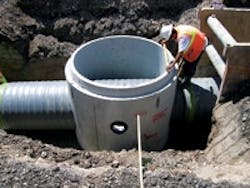About the author: Steve Cooper is a writer for SCA Communications. Cooper can be reached at [email protected] or 516.623.7615.
The collapse of an existing sanitary sewer line in Logan, Utah, in May 2011 compelled the city to develop fast-track plans for replacing the entire 1-mile-plus run. The 18-in.- diameter concrete pipeline was replaced and upsized using almost 6,000 ft of SaniTite HP pipe from Advanced Drainage Systems Inc. (ADS). The pipe is made from a specific grade of polypropylene resin to resist harsh chemicals and gases such as hydrogen sulfide, which led to the failure of the original line.
Pipeline Overhaul
The problem in Logan occurred as the Utah Department of Transportation (UDOT) was reconstructing State Road 252, 1000 West with a new surface in May 2011. A new sewer line was planned for future installation.
“During construction another utility company was working near the existing 18-in. reinforced concrete pipe sewer line,” said Paul Lindhardt, P.E., a city of Logan employee. “[This one] collapsed during the construction and caused a big emergency with sewage backing up into basements. As we checked it out, we found there was a great deal of corrosion. In some areas the existing pipe had deteriorated to the point that the only thing left of the original concrete pipe was mostly aggregate.”
The original sewer line was installed around 1970.
“When it collapsed it caused a big sink hole in the roadway that vehicles could have driven into,” Lindhardt said. “With the new concrete highway being built on top, we decided we needed to replace the entire run now, not just a few sections. So, in a matter of four weeks, we put together an entire design for approximately 5,200 ft of sewer line, talked to different companies and chose SaniTite as the pipe to use. The new pipe was installed parallel to the old line. We ended up filling the original pipe with flowable fill because we couldn’t risk any more of it collapsing.”
The city of Logan, located 80 miles north of Salt Lake City, has seen its population more than double to 50,000 residents since the mid-1970s. It is projected to double again by 2042.
“We upsized the existing 18-in. trunk line to 36 in. and upsized the existing 36-in. line to 48 in.,” Lindhardt said. “We knew that if we used the same size pipe it would have capacity issues, not immediately, but in the future. Additionally, because it’s a state highway, we upsized the pipe to meet the ultimate build-out projections of the city. This way it shouldn’t have capacity issues in the future. The planned peak flow rate is about 5,100 gal per minute [gpm] in the 36-in. pipe and approximately 10,000 gpm in the 48-in. pipe portion.”
Lateral runs were made up of 15-, 18- and 24-in. pipe. Burial depth of 36-in.-diameter pipe ranged from 9 to 12 ft, while the 48-in. pipe’s burial depth ranged from 11 to 13 ft. Overall project depth measured 10 to 12 ft. Construction commenced in July and took eight weeks.
The Plusses of Plastic
Manufactured in 30- to 60-in. diameters, the pipe is available in triple-wall construction that provides a smooth interior- and exterior-wall design supported by a corrugated structural core for improved stiffness and greater beam strength to minimize deflection and enhance long-term performance. It meets the ASTM F2764 regulation and exceeds the requirements of ASTM D3212 for water tightness with dual gaskets and banded reinforced bell. Rugged and lightweight, the pipe is easily handled with minimal equipment and crew. Its long “stick” length reduces the number of joints, which also saves time and labor and makes for a more secure system versus the several ton weight of each short section of comparable reinforced concrete pipe.
“Plastic pipe is an excellent product for sanitary sewer use,” said Tony Radoszewski, executive director for the Plastic Pipe Insitute. “It is easy to move and install, and it can withstand virtually any effluent found in sanitary sewers. This feature was critical in order to respond to the collapse of the concrete pipe in the most timely manner.”
About the Author
Steve Cooper
Steve Cooper is a writer for SCA Communications. Cooper can be reached at [email protected].
